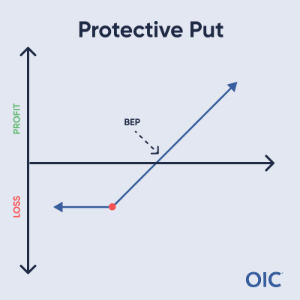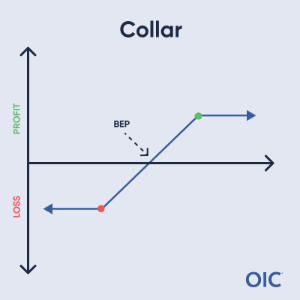July Webinar Key Takeaways: Hedging With Options
In July, OIC hosted two webinars, The Protective Put: Managing Downside Risk and The Collar Strategy: Balancing Risk and Potential Reward, led by OIC instructor Roma Colwell. The traditional collar, which combines a protective put with a covered call, was explained as a potential approach to reduce downside exposure, with the premium collected from selling the call helping to offset the cost of the protective put, though at the expense of capping upside potential. The session also highlighted the put-spread collar strategy, which defines a specific range of protection and provides a predetermined exit and re-entry point for a declining stock. Supporting strategies, including protective puts and covered calls, were reviewed to illustrate how collars integrate downside protection with premium income generation to create a balanced risk-reward approach for long stock positions or portfolios.

What We Covered:
- Protective Put Strategy: A protective put is a risk management strategy used to safeguard a stock or portfolio against decrease in value. It involves purchasing a put option as insurance, providing downside protection while retaining upside potential. The cost of this protection depends on the selected strike price and the time remaining until expiration.
- Covered Call Strategy: A covered call is an options strategy where an investor sells call options against an existing long stock position to generate premium income. The options premium received from selling the call provides immediate cash flow while an investor holds the shares of the underlying assets.
- Traditional Collar Strategy: A traditional collar combines a protective put with a covered call to create a balanced risk-management strategy. The protective put provides downside protection by acting as insurance against significant losses in the underlying stock, while the covered call generates income by collecting a premium. The premium received from selling the call helps offset, partially or fully, the cost of purchasing the protective put.

- Put Spread Collar: A put spread collar enhances the traditional collar by adding a further out-of-the-money (OTM) short put. This defines a specific range of protection and establishes a predetermined lower re-entry price, allowing the investor to potentially exit and later re-enter the long stock position at that lower level.
- Strike Price Selection: Strike price selection is essential for evaluating risk and reward, aligning with an investor’s risk tolerance and market outlook; higher put strikes offer greater protection at higher cost, while lower strikes provide limited, more affordable protection.
Keep Learning:
- Key Moments From The Protective Put: Managing Downside Risk
- Key Moments From The Collar Strategy: Balancing Risk and Potential Reward
Meet OIC instructor Roma Colwell:

Roma Colwell
Roma brings over 27 years of experience in the financial industry, having served as a floor broker, market maker, risk manager, and educator on both the Pacific Stock Exchange (PSE®) and Cboe® Global Markets, formerly Chicago Board Options Exchange.
Cboe® is a Registered Trademark of the Chicago Board of Options Exchange (Cboe)
PSE®is a Registered Trademark of the Pacific Stock Exchange

